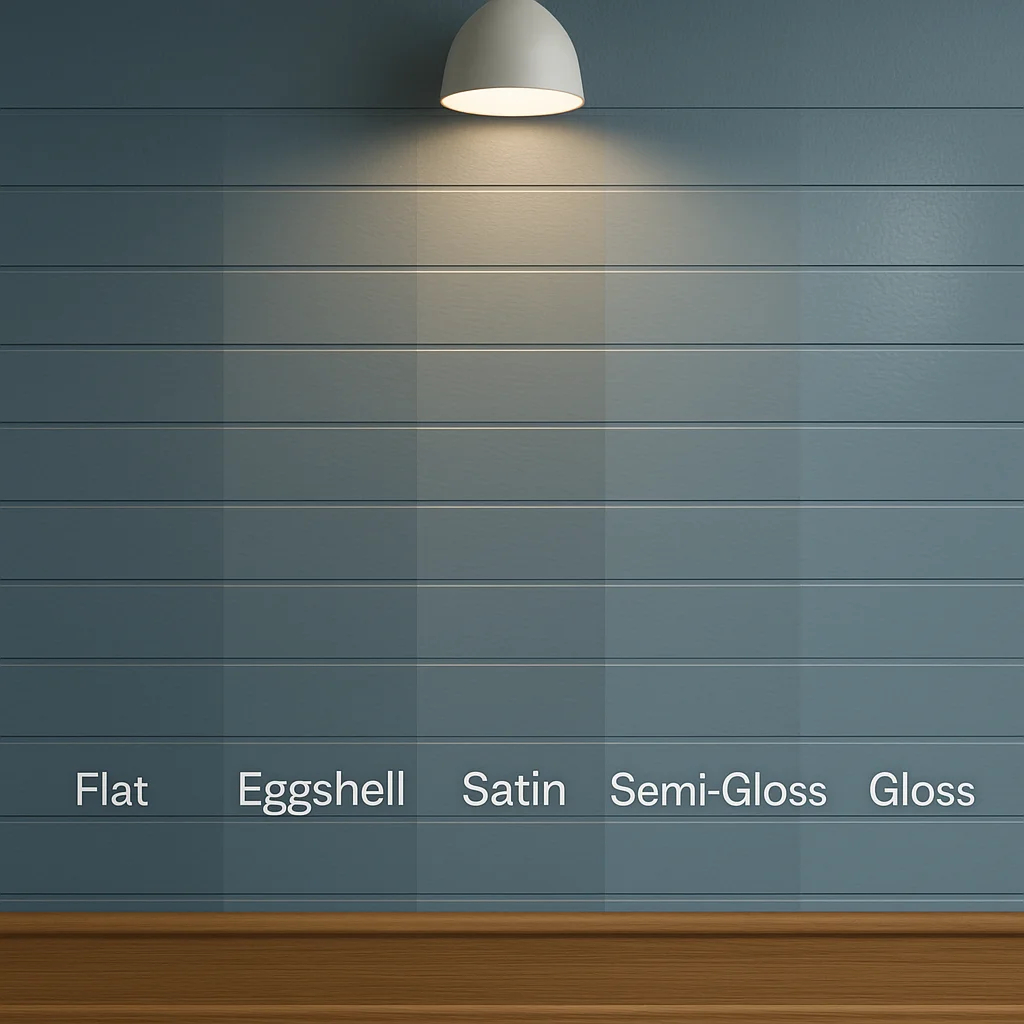US levin.com Painting crew has found through experience that a systematic approach to interior painting helps us to deliver a quality interior paint job. Below are the general steps we will take on your interior painting project. Your situation may vary depending upon your needs as outlined on your Proposal.
Call 347-740-0022 anytime... day or night
for free estimate!

Can’t Decide on Colors?
Sheens
Choosing the right paint sheen is crucial for achieving the desired look and durability in your interior spaces. Our Interior Painting Services guide will help you understand different paint sheens to make the best choice for your home or office.
Higher Sheen Paints (Semi-Gloss & Gloss): Ideal for high-traffic areas like kitchens and bathrooms due to their durability and ease of cleaning.
Lower Sheen Paints (Flat & Eggshell): Suitable for low-traffic areas; they require more care as they are less resistant to scrubbing.
High Sheen Paints: Reflect more light, making surface flaws more noticeable—best applied on smooth, well-prepared walls.
Low Sheen Paints: Offer a matte finish that effectively hides imperfections, perfect for ceilings and uneven surfaces.
Flat Paint: No sheen, great for ceilings and low-traffic areas.
Eggshell Paint: Subtle sheen, ideal for living rooms and bedrooms.
Satin Paint: Medium sheen providing a smooth finish, perfect for hallways and family rooms.
Semi-Gloss Paint: Reflective sheen, excellent for kitchens, bathrooms, and trim.
Gloss Paint: High sheen, best for doors, cabinets, and decorative features.
Note: Sheen levels may vary slightly depending on paint manufacturers. Consult with our Interior Painting Services experts for personalized advice and professional application.

We have over 15 years of experience providing professional interior painting services.
Looking to refresh your home with a professional interior paint job? At USLevin.com, our NYC-based painting team follows a proven, step-by-step approach to deliver flawless interior painting results every time.
-
Expert prep: holes filled, stains sealed, surfaces sanded
-
High-quality paint application with uniform finish
-
Assistance with color and sheen selection
-
Complete cleanup and furniture repositioning
-
Free in-home estimate and color consultation
Serving homes and apartments across NYC—schedule your free interior painting quote today!
Call 347-740-0022 now for your no-obligation estimate!

FAQ
How much does an interior painting project cost?
The cost of an interior painting project depends on the size of the area, number of rooms, ceiling height, wall condition, and paint type. On average, it costs between $2 and $6 per square foot. For a full-house interior repaint, homeowners typically spend between $3,000 and $8,000.
How long does interior painting take?
A standard interior painting project takes 2 to 5 days for an average-sized home. Factors such as surface preparation, number of coats, drying time, and whether ceilings and trim are being painted will affect the timeline. Larger or more detailed projects may take up to a week or more.
What type of paint finish should I use for each room?
Different rooms benefit from different paint finishes. Flat or matte is ideal for ceilings and low-traffic areas. Eggshell is great for living rooms and bedrooms. Satin is commonly used in kitchens, bathrooms, and hallways due to its durability and cleanability. Semi-gloss and gloss are best for trim, doors, and cabinets.
Do I need to move my furniture before painting?
Yes, it’s recommended to move furniture away from walls or out of the room before painting. If full removal isn’t possible, items should be moved to the center and covered with plastic sheets. Proper preparation protects furniture and allows painters to work efficiently and safely.
Is primer necessary before interior painting?
Primer is essential for painting over new drywall, stained or repaired surfaces, or when making drastic color changes. It helps the topcoat adhere better and ensures a uniform finish. Some premium paints include built-in primer, but a separate primer layer may still be recommended for best results.
What colors are trending for interior walls?
Popular interior paint colors include soft neutrals like warm beige, greige, and ivory, along with muted earth tones and calming blues and greens. Darker shades like navy, charcoal, and forest green are also trendy for accent walls. Choosing timeless colors can boost aesthetic appeal and resale value.
How can I prepare my walls before painting?
Wall preparation includes cleaning dust and grease, filling holes and cracks, sanding rough patches, and applying painter's tape to edges. Clean, dry, and smooth walls ensure proper paint adhesion and a long-lasting finish. Skipping prep work can lead to visible imperfections and paint failure.
Is it safe to stay in my home during painting?
Yes, especially if low-VOC or zero-VOC paints are used. Proper ventilation is key—open windows and use fans to help dissipate fumes. Some oil-based or high-VOC paints may emit strong odors, in which case temporarily avoiding the painted area is advisable until it fully dries.
How does interior painting increase home value?
A fresh interior paint job boosts home value by improving visual appeal, creating a clean and updated look, and making spaces appear brighter and more spacious. Neutral, modern colors attract buyers and help homes sell faster. It’s one of the most cost-effective upgrades for resale.

